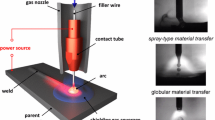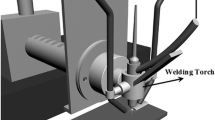Abstract
This paper presents extensive investigations about the influence of He-additions to argon TIG-arc properties. Results of diagnostic methods, numerical simulations and welding trials are combined to improve the comprehension about the mode of action of gas mixtures. Additionally, selected results of the investigation with H2- and N2-additions are summarized. The investigations show that all gas additions cause an increase of the heat input into the workpiece. However, the stagnation pressure depends on the gas composition: He-additions result in a decrease of the stagnation pressure which depends on the arc length, whereas H2-and N2-additions increase the pressure. By a systematic choice of the gas mixture the weld depth and also the maximum feed speed can be influenced.
Similar content being viewed by others
References
Brune E.: Das richtige Gas für jede Schweissaufgabe, The right gas for every welding task, Technica, 2004, vol. 25-26, no. 1, pp. 48–52 (in German).
Felber S.: Schweiβtechnik im Pipelinebau (Teil 3b), Welding in pipeline construction, Schweiβ- und Prüftechnik, 2004, vol. 3, no. 3, pp. 35–38 (in German).
Hunt C., Bols I. and Ortega P.: Helium — a lightweight gas but a heavyweight performer, Welding & Metal Fabrication, 1997, vol. 65, no. 6, pp. 10–15.
Nestor O. H.: Heat intensity and current density distribution at the anode of high current, inert gas arcs, Linde Company, Division of Union Carbide Corporation, Indianapolis, Indiana, 1961.
Tsai N.S. and Eager T.W.: Distribution of the heat and current fluxes in gas tungsten arcs, Metallurgical Transactions B, 1985, vol. 16B, no. 4, pp. 841–846.
Lin M.L. and Eagar T.W.: Pressures produced by gas tungsten arcs, Metallurgical Transactions B, 1986, vol. 17B, no. 3, pp. 601–607.
Murphy A.B.: Cataphoresis in electric arc, Journal of Physics D: Applied Physics, 1998, vol. 31, no. 23, pp. 3383–3390.
Murphy A.B., Tanaka M., Tashiro S., Sato T. and Lowke J.J.: A computational investigation of the effectiveness of different shielding gas mixtures for arc welding, Journal of Physics D: Applied Physics, 2009, vol. 42, no. 11, pp. 115205–115219.
Murphy A.B. and Hiraoka K.: A comparison of measurements and calculations of demixing in free-burning arcs, Journal of Physics D: Applied Physics, 2000, vol. 33, no. 17, pp. 2183–2188.
Lowke J.J., Morrow R., Haidar J. and Murphy A.B.: Prediction of gas tungsten arc welding properties in mixtures of argon hydrogen, IEEE Transactions on Plasma Science, 1997, vol. 25, no. 5, pp. 925–930.
Sansonnens L., Haidar J. and Lowke J.J.: Predictions of properties of free burning arcs including effects of ambipolar diffusion, Journal of Physics D: Applied Physics, 2000, vol. 33, no. 2, pp. 148–157.
Lowke J.J., Morrow R. and Haidar J.: A simplified unified theory of arcs and their electrodes, Journal of Physics D: Applied Physics, 1997, vol. 30, no. 14, pp. 2033–2042.
Lowke J.J. and Tanaka M.: ‘LTE-diffusion approximation’ for arc calculations, Journal of Physics D: Applied Physics, 2006, vol. 39, no. 16, pp. 3634–364.
Füssel U., Schnick M., Fuentes Munoz J.E., Zschetzsche J. and Siewert E.: Experimental possibilities of gas tungsten arc analyses, Welding and Cutting, 2007, vol. 6, no. 5, pp. 282–287.
Uhlenbusch J., Fischer E. and Hackmann J.: Experimentelle und theoretische Untersuchungen von Nichtgleichgewichtseffekten an stationären Heliumplasmen unter Normaldruck, Experimental and theoretical analyses on non-LTE-effects of steady state He-plasma under normal pressure, Zeitschrift der Physik, 1970, vol. 238, pp. 404–420 (in German).
Author information
Authors and Affiliations
Corresponding author
Rights and permissions
About this article
Cite this article
Zähr, J., Füssel, U., Hertel, M. et al. Numerical and Experimental Studies of the Influence of Process Gases in Tig Welding. Weld World 56, 85–92 (2012). https://doi.org/10.1007/BF03321338
Published:
Issue Date:
DOI: https://doi.org/10.1007/BF03321338




